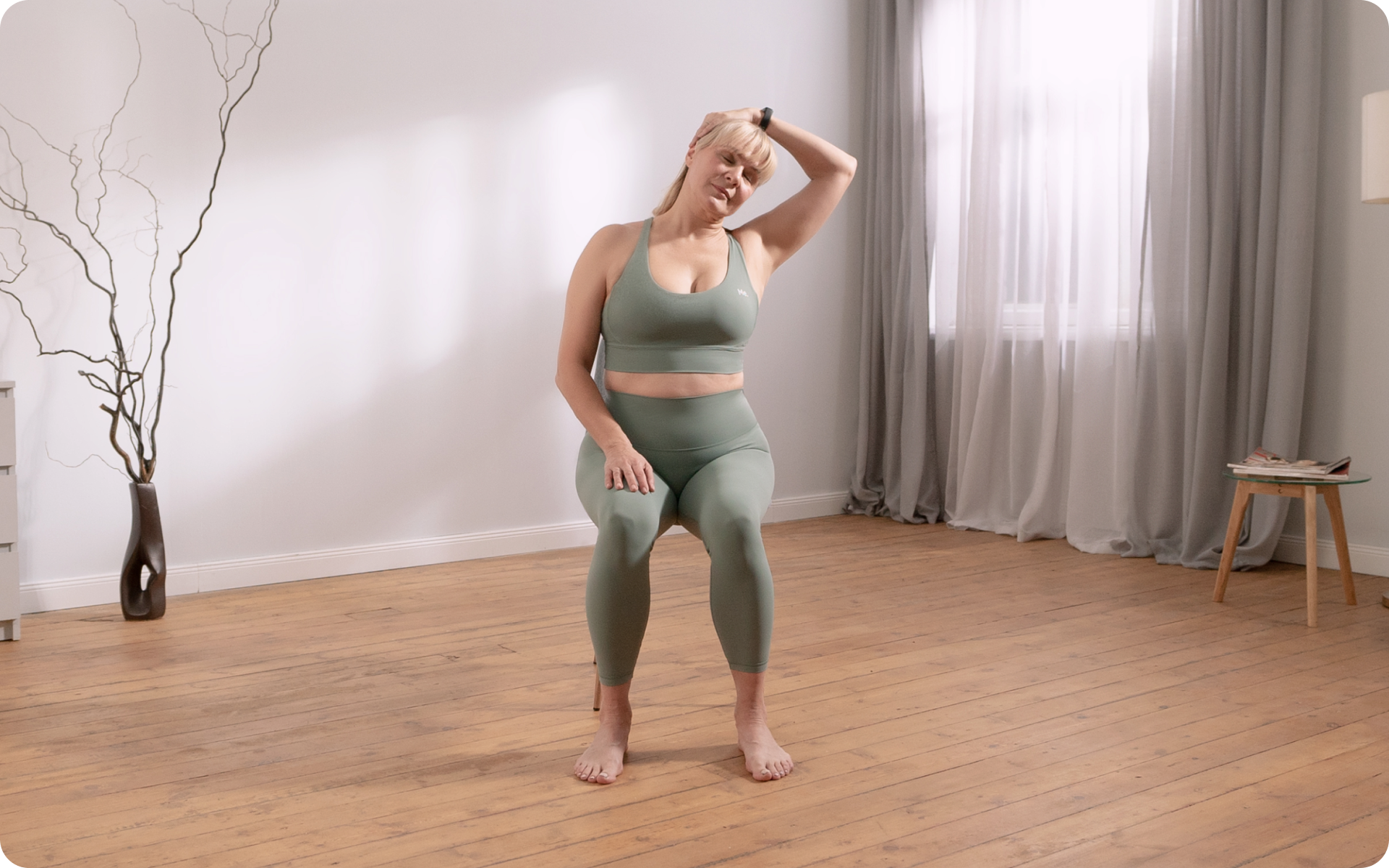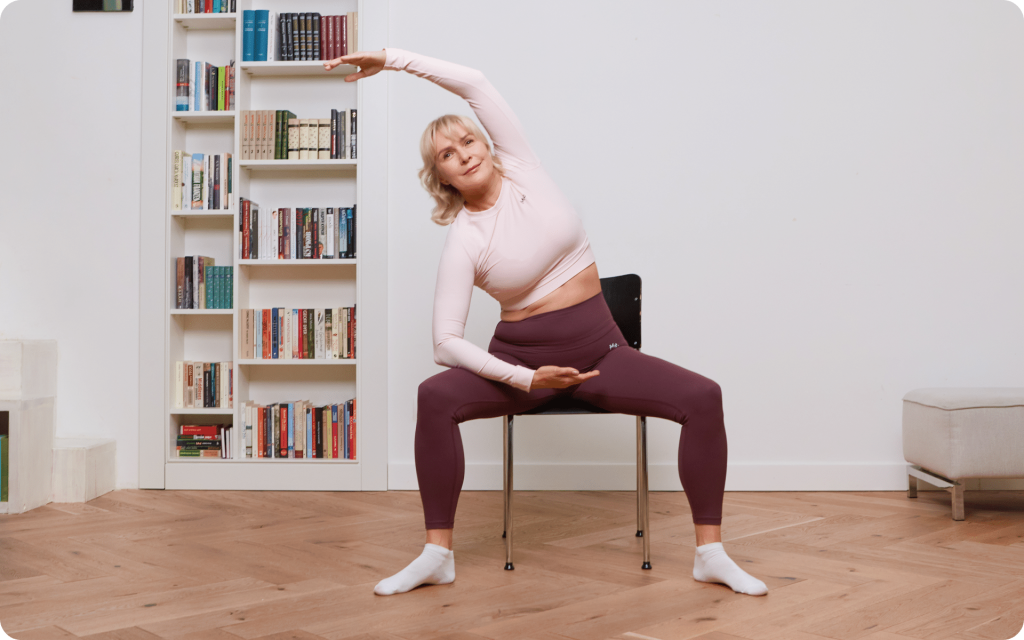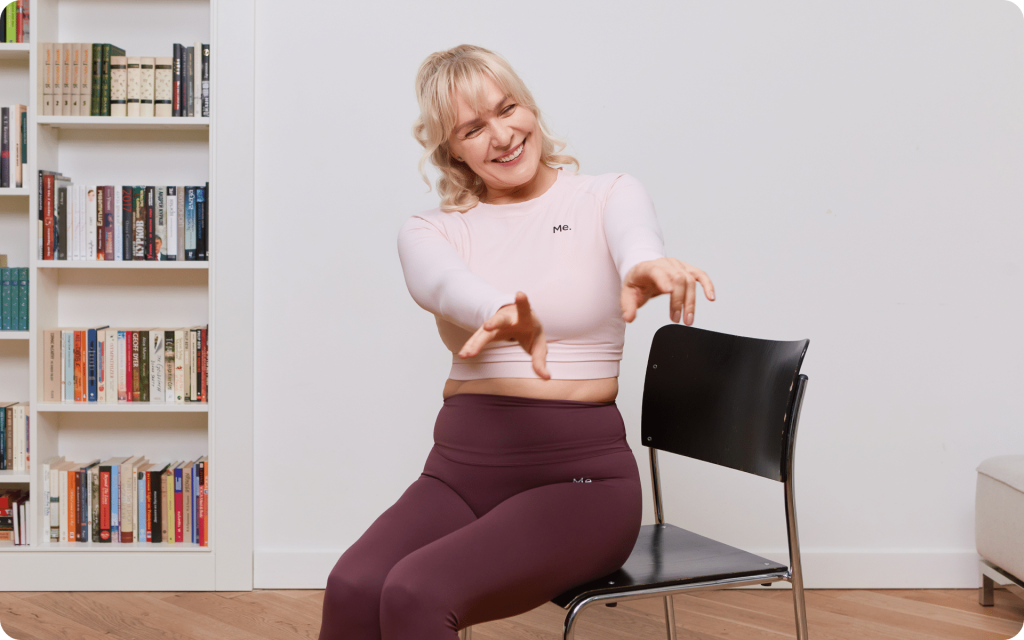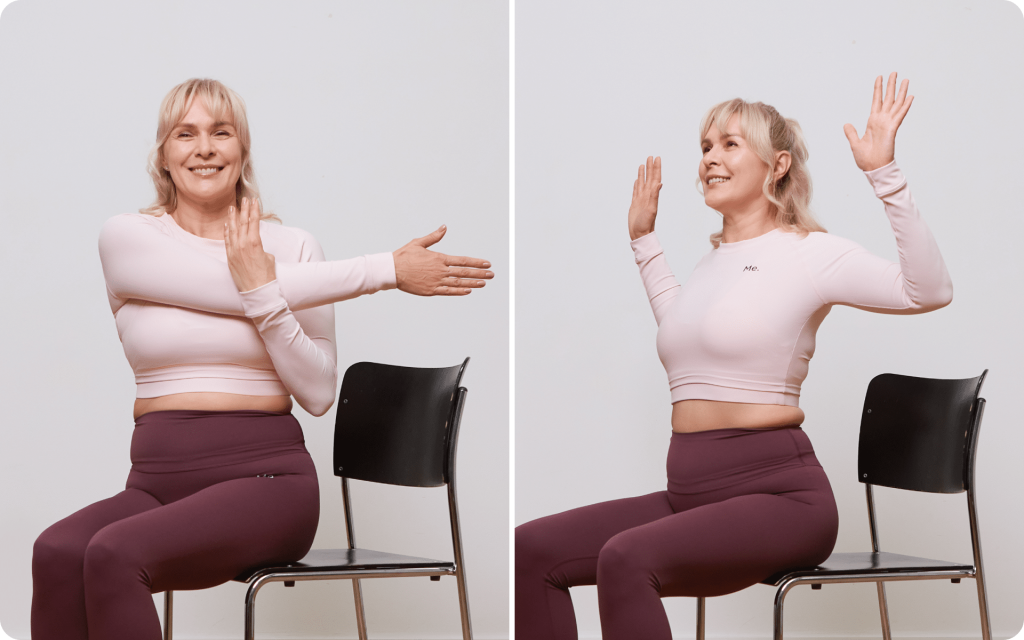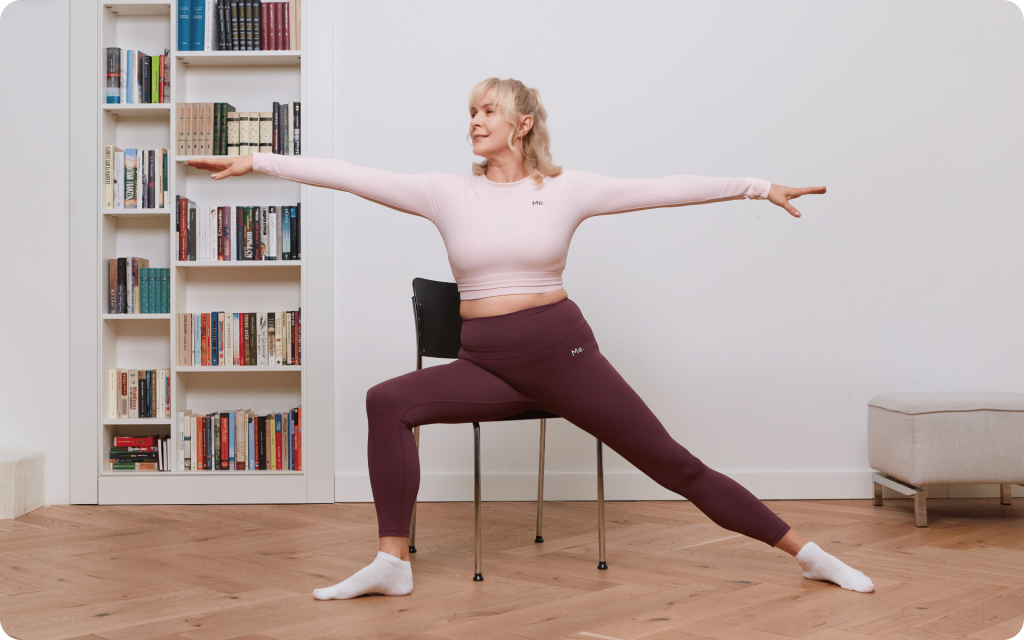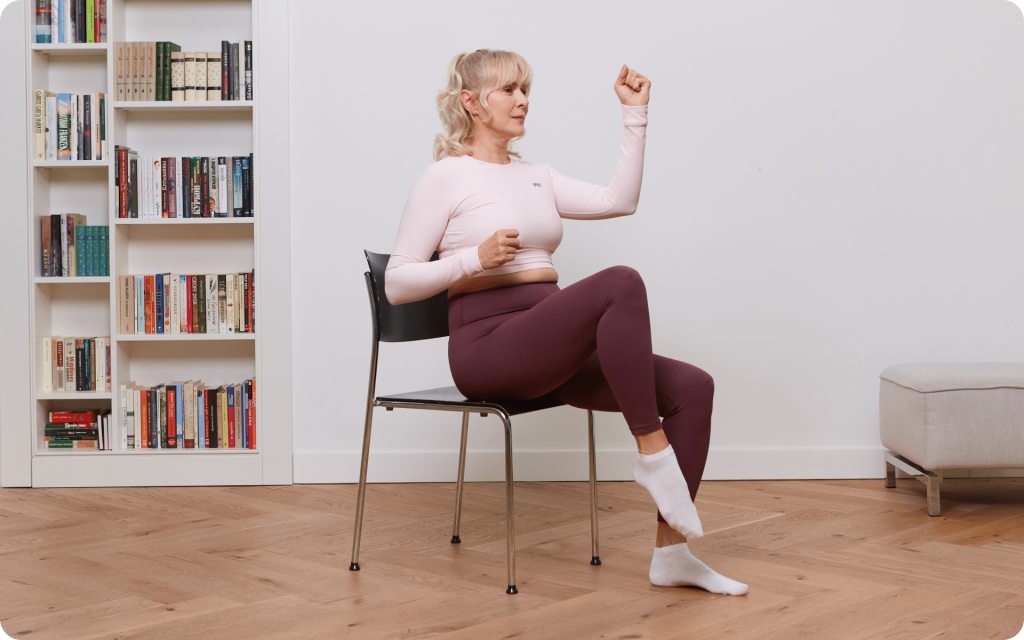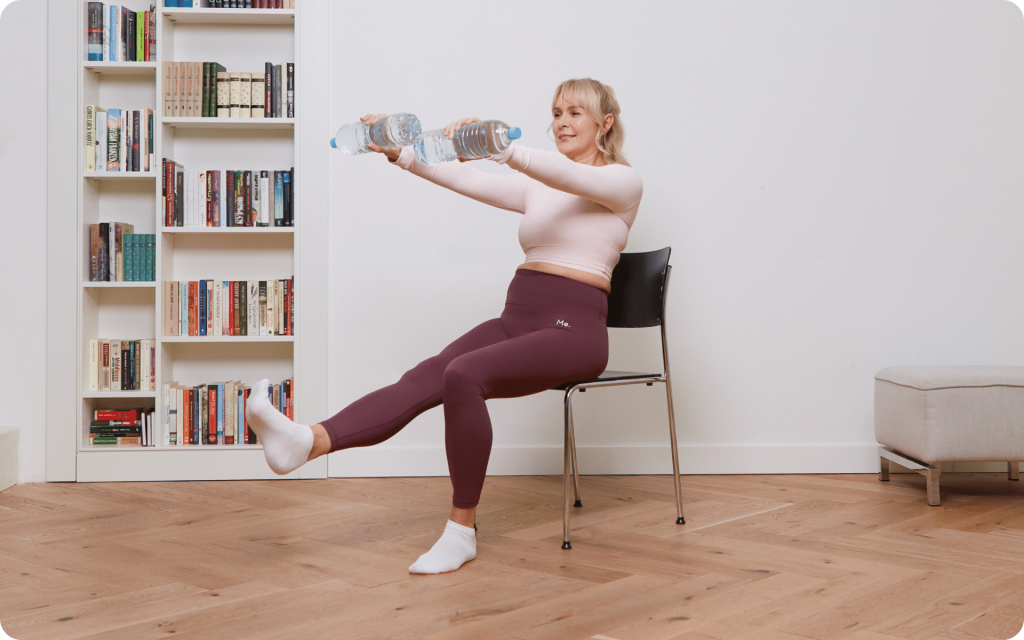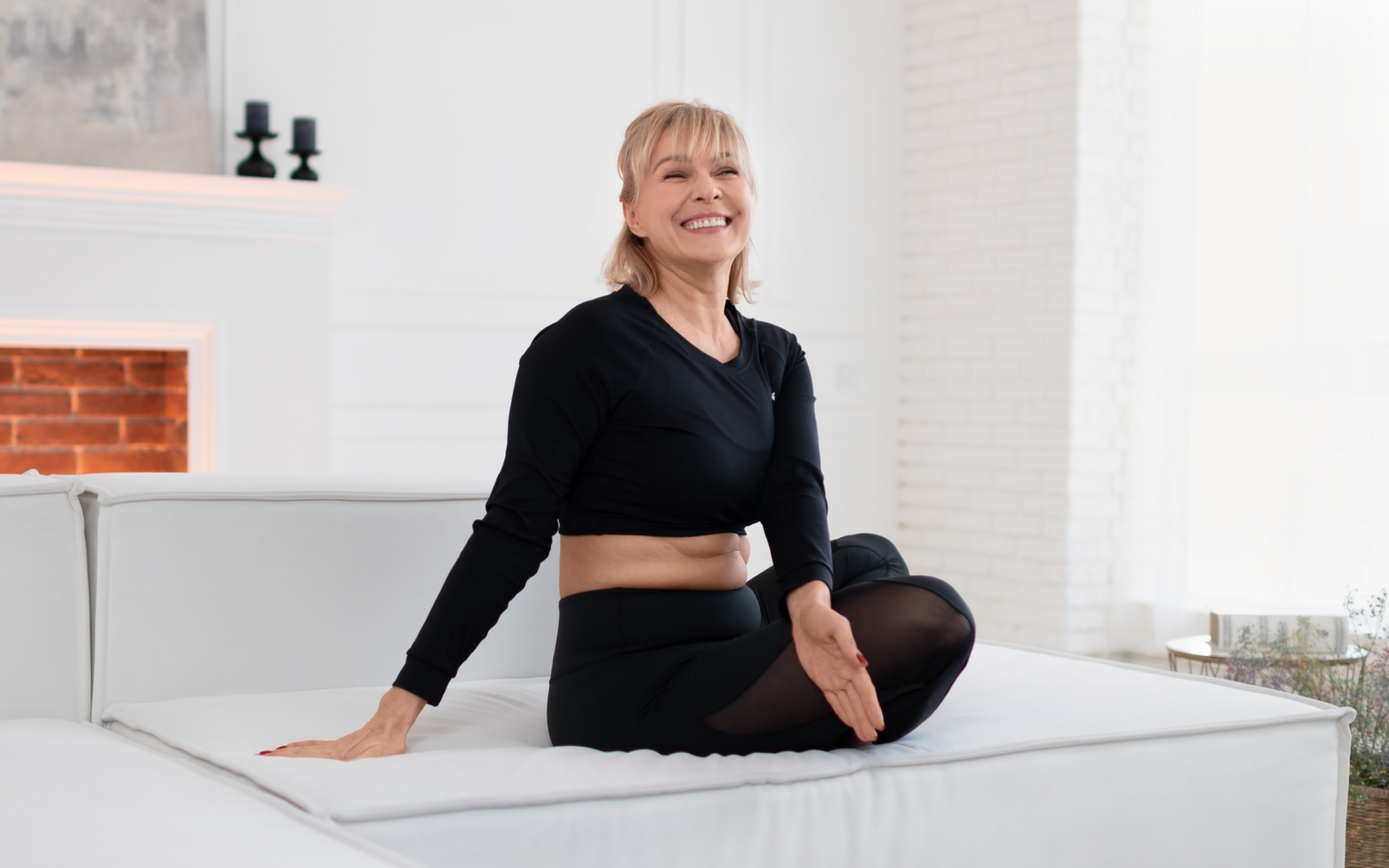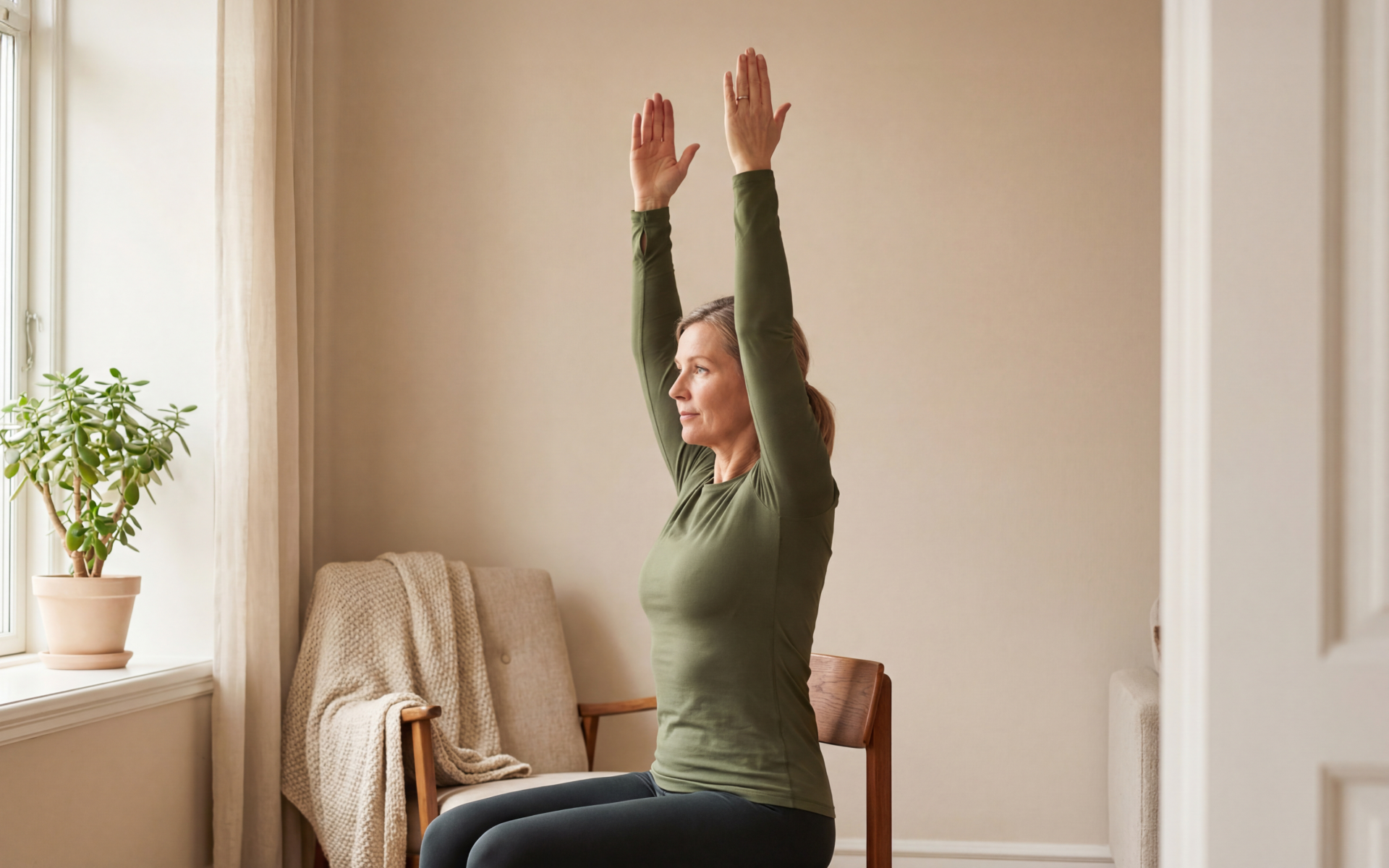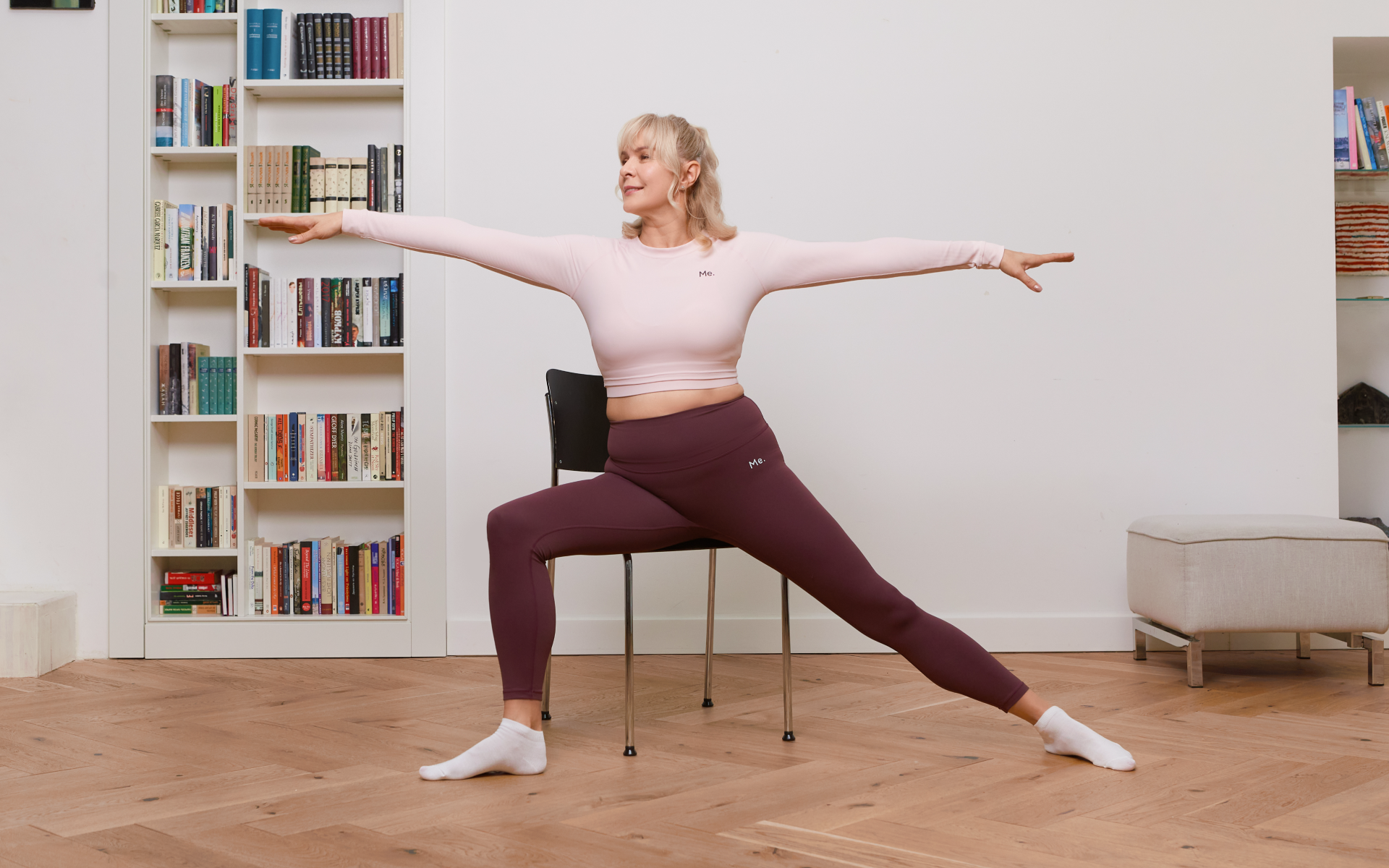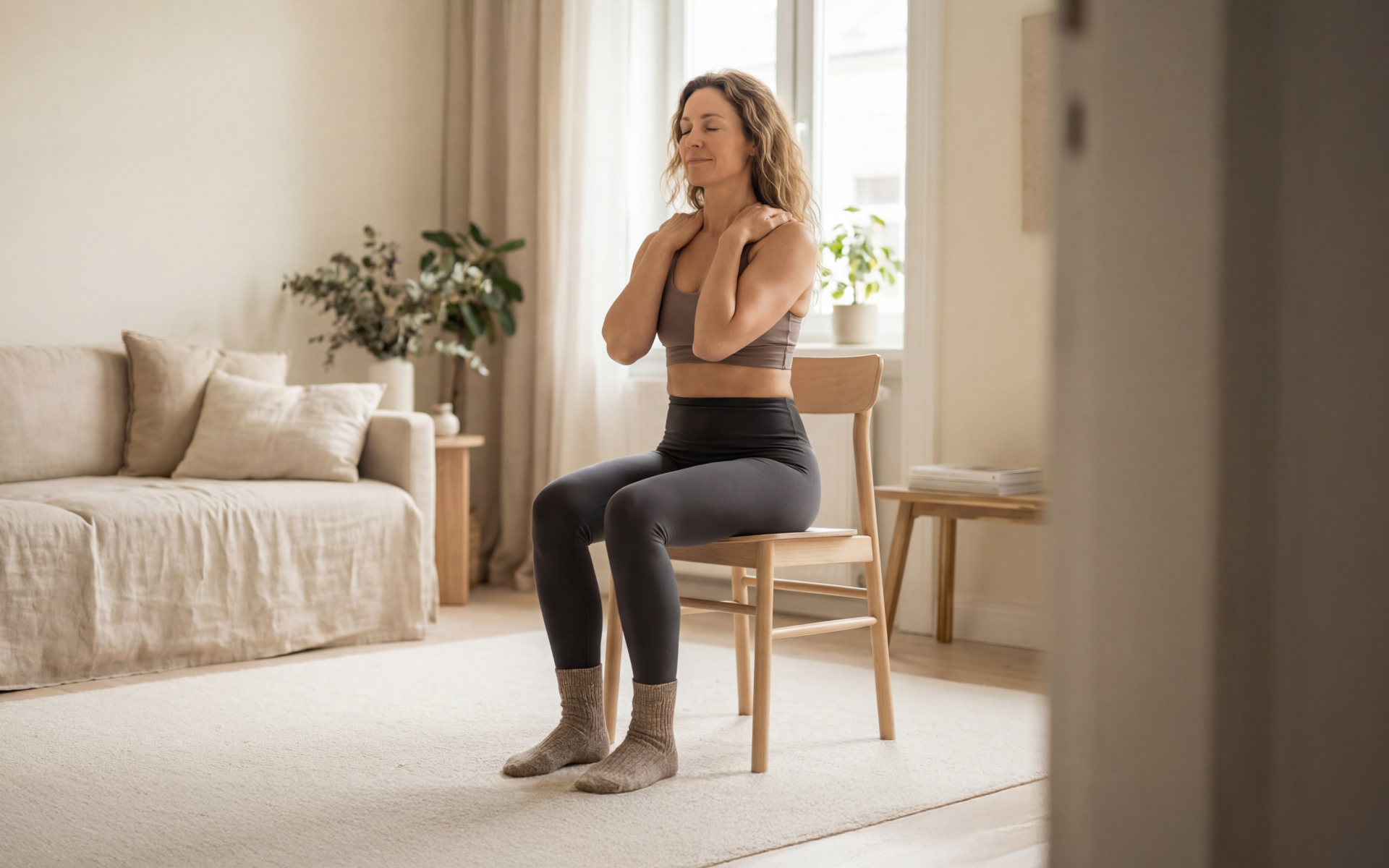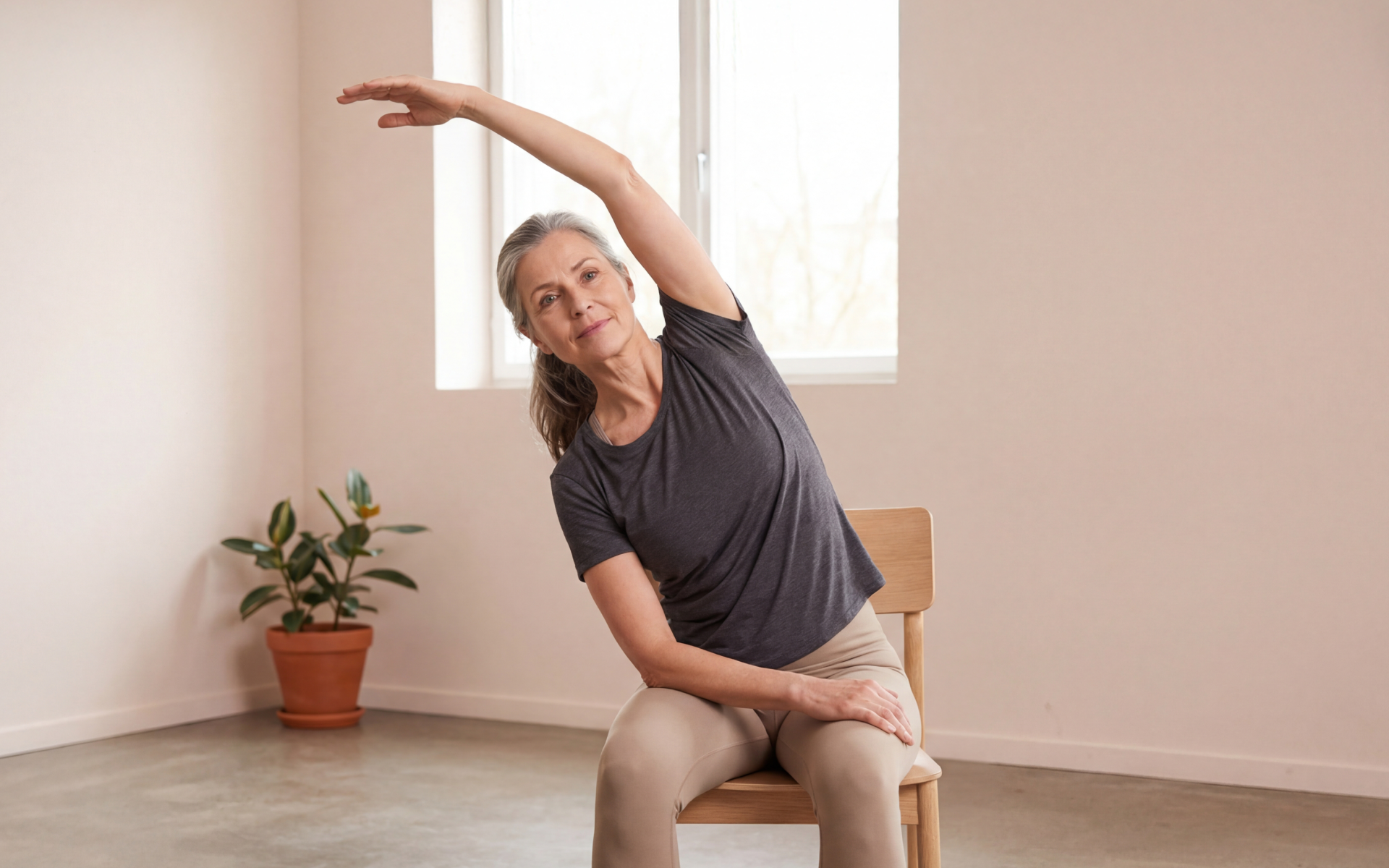Chair yoga is exactly what it sounds like – gentle, effective yoga poses that are done while seated or using a chair for support. It’s an approachable option for anyone, whether you’re new to yoga, working around an injury, or just looking for a way to stretch at your desk.
One pose worth spotlighting is the side stretch. This simple yet effective movement is designed to awaken the sides of your body, improve flexibility, and release tension stored in your back, shoulders, and sides. What’s great is that it doesn’t require anything beyond a sturdy chair and a willingness to give it a try.
Here’s how to master the side stretch and everything else you need to know.
What Does Seated Side Stretch Do?
Although it’s a beginner-friendly pose, the seated side stretch has immense potential for those who practice it with care and consistency. Over time, it:
- Enhances Side Flexibility
The seated side stretch focuses on lateral flexion, which simply means bending to the side. This movement stretches and lengthens the muscles along the sides of your torso, including the obliques (muscles that run diagonally along your core ). Over time, regular practice can increase flexibility in these areas (1), which makes everyday movements such as reaching or twisting easier and more comfortable.
- Promotes Spine Health
Your spine is meant to move in multiple directions, but throughout the day most people spend a lot of time using the spine to move forward and backward. A seated side stretch introduces lateral movement to your spine, which can help maintain its natural mobility. By gently elongating the vertebrae and surrounding muscles, this pose encourages space between the disks, potentially reducing stiffness or discomfort (2). Our previous article covers everything you need to know about chair yoga strech benefits.
- Stimulates the Breath
The side stretch opens the intercostal muscles, which are the small muscles that are located between the ribs. These muscles play a vital role in expanding your rib cage when you breathe. Stretching them can promote deeper, more relaxed breathing patterns (3). This is aligned with yogic principles such as “pranayama”, the control of breath, which is central to finding balance and calm in both body and mind.
Reasons why BetterMe is a safe bet: a wide range of calorie-blasting workouts, finger-licking recipes, 24/7 support, challenges that’ll keep you on your best game, and that just scratches the surface! Start using our app and watch the magic happen.
- Releases Tension
Modern life often leads to tightness in the shoulders, upper back, and sides due to minimal postural variation throughout the day. The seated side stretch works to release stored tension in these areas. With each mindful stretch, you may feel a sense of relief and relaxation, helping you combat the physical effects of stress (4).
- Supports Core Stability
Although it seems gentle, the seated side stretch engages your core muscles, including the obliques and deeper stabilizers around your spine. These muscles help maintain balance and upright posture during the pose. Over time, practicing this stretch can contribute to greater core awareness and stability, which are building blocks for overall functional strength (5).
- Balances Energy Flow
In Sanskrit, this pose is called “Parsva Ustrasana” when done in a full kneeling position, but its seated variation applies similar principles. The lateral movement is believed to help balance energy, or “prana”, particularly along the sides of the body. Yoga philosophy teaches that this can help restore a sense of harmony and vitality, both physically and mentally (6).
- Encourages Joint Mobility
Beyond the muscles, the seated side stretch also benefits the joints. The gentle lateral motion encourages mobility in the shoulders, spine, and hips. If performed safely and consistently, it can lubricate these joints, promoting smoother, pain-free movement over time (7).
- Invites Mindfulness
Yoga isn’t just about physical benefits, it’s also a path to mindfulness. The seated side stretch encourages slow, intentional movement. By focusing on your form, breath, and sensations, you cultivate awareness of your body. This mindful approach can bring a sense of calm, which makes it as much a mental exercise as a physical one (8).
Read more: 7 Chair Yoga Exercises for Seniors to Relieve Stiffness
What Is the Name of the Yoga Sitting Side Stretch?
When people refer to the yoga sitting side stretch, they’re often describing a variation of “Parsva Sukhasana”. This translates to “seated side bend”, combining “Parsva” (side) and “Sukhasana” (easy seated pose). It’s a modified version of the traditional seated pose with the addition of a gentle lateral bend.
However, this stretch isn’t limited to one seated position. Depending on how it’s performed, it can also draw inspiration from other poses. For example, if done with legs extended forward, it resembles “Parsva Upavistha Konasana,” or side bend in wide-angle seated pose.
The key feature of these variations is the side bend itself. This movement stretches the torso laterally, regardless of the base position of your legs.
Many teachers simply call it a “seated side stretch” or “chair side stretch” when cueing the pose for accessibility and clarity, especially in beginner or chair yoga classes. While the Sanskrit names carry tradition, the translation of this word into English can help people understand what this movement is all about.
Regardless of the name, the essence of this pose lies in stretching the side body with awareness and ease.
How to Do a Chair Yoga Side Stretch
The chair yoga side stretch is a gentle but effective pose. Performing it correctly ensures you gain its full benefits without any risk of strain. Below is a clear guide to help you execute it with confidence, including step-by-step instructions, alignment tips, and safety precautions.
Step 1: Get Seated Comfortably
Sit on a sturdy chair with a straight back. Position your feet flat on the floor, hip-width apart. Your knees should form a 90-degree angle. Relax your shoulders and keep your back upright.
Step 2: Ground Through Your Sit Bones
Feel for the bony points at the bottom of your pelvis, which are known as your sit bones. Press both of them evenly into the chair for stability. This provides a solid and balanced base for the stretch.
Step 3: Engage Your Core
Activate your abdominal muscles slightly. This support helps protect your lower back and ensures good posture during the pose.
Step 4: Lengthen Through the Spine
Sit as tall as possible, imagining a string gently pulling the crown of your head upward. Maintaining a long spine ensures proper alignment and maximizes the impact of the stretch.
Step 5: Stretch One Arm Overhead
On an inhale, lift your right arm up toward the ceiling. Keep your palm facing inward and your arm extended, but not rigid. Relax your shoulder, avoiding a shrugging motion.
Step 6: Lean Gently to the Side
Exhale as you slowly bend your upper body to the left. Keep the movement controlled. Rest your left hand lightly on the chair for stability. The stretch should come from your side, not from twisting or hunching forward.
Whether you’re a workout beast or just a beginner making your first foray into the world of fitness and dieting – BetterMe has a lot to offer to both newbies and experts! Install the app and experience the versatility first-hand!
Step 7: Keep the Hips Anchored
Ensure both sides of your pelvis remain firmly grounded in the chair. Do not allow one hip to lift as you bend. This keeps the stretch targeted on the side of your body.
Step 8: Hold and Breathe
Pause in the stretch and take 3-5 deep breaths. Focus on sending your breath into the side of your torso that’s stretching. Each exhale allows your body to soften into the pose without forcing it.
Step 9: Return to Neutral
On an inhale, bring your upper body back to the center and gently lower your right arm. Take a moment to reset before repeating the stretch on the left side.
Tips for Proper Alignment
- Keep your chest facing forward throughout the stretch. Twisting reduces its effectiveness.
- Envision creating space between each rib as you stretch to encourage a deeper side-body lengthening.
- Perform the pose slowly and deliberately to maintain balance and proper form.
Safety Precautions
- Never force the stretch. It should feel comfortable, not strained.
- Focus on breathing throughout this movement. Exhaling can help you get deeper into the stretch.
- If you experience tension in your neck, keep your head looking forward rather than up.
- Those with lower back issues should prioritize keeping the spine long and avoid over-bending.
What Is the Purpose of the Chair Yoga Side Stretch?
The chair yoga side stretch serves a deeper intention beyond just stretching your body. At its core, this pose embodies the yogic principles of balance, awareness, and connection. Each movement is designed to align the physical body with the inner self, fostering harmony both inside and out.
This pose facilitates lateral expansion. Stretching the side body helps create physical space, not just between ribs but within yourself. Yogis believe that as you lengthen, you encourage prana (life force energy) to flow more freely. This expanded flow can leave you feeling less constricted, both physically and mentally (6).
The pose also invites mindfulness and breath awareness. By bending to one side and focusing on the stretch, you naturally slow down and tune in. The breath becomes your guide, teaching you to move with intention rather than force. This aspect of the practice reflects the yogic idea that the union of breath and movement helps unite the mind and body (9).
Energetically, lateral stretches are linked to releasing stagnation in the ribcage and along the sides of the torso. These areas often hold tension from shallow breathing or poor posture. By consciously stretching, you engage in a gentle process of release, encouraging openness and relaxation.
From a philosophical standpoint, the purpose of this pose is aligned with self-compassion. Chair yoga, particularly modifications such as the side stretch, reminds us that yoga meets us where we are. It’s not about perfection or pretzel-like poses. Instead, it’s about moving mindfully within your current capabilities, honoring your body in the moment.
Read more: The Ultimate 30-Minute Chair Yoga Routine For Every Body
What Are the Benefits of the Chair Yoga Side Stretch?
The chair yoga side stretch offers unique advantages that make it approachable, supportive, and versatile:
- Accessibility for All Levels – The chair makes the pose manageable for beginners, older adults, or those with limited mobility. You can stretch effectively without needing to get down to or up from the floor. For more details about chair yoga side for beginners, take a look at our prior publication.
- Added Stability – The seated position ensures more balance and control. This reduces the risk of tipping or losing alignment, particularly for those with balance challenges.
- Ease on the Joints – Sitting in a chair removes pressure from knees, hips, and ankles. This makes it a great option for anyone with joint sensitivity or arthritis.
- Customizable Depth – With the chair for support, you can modify the intensity of the stretch. Whether you’re looking for a light opening or a deeper side-body release, you can adjust without strain.
- Encourages Proper Alignment – The chair helps you maintain a neutral spine and grounded pelvis. These cues are easier to follow when you’re seated, leading to a more effective stretch.
- Supports Breathwork – Sitting allows you to direct more awareness toward your breath. This adds a layer of calm and mindfulness to the practice while deepening the stretch.
- Office-Friendly Option – As the pose only requires a chair, it’s an ideal stretch for the workplace. You can sneak it into your daily routine without breaking a sweat.
- Strengthens Seated Posture Awareness – By practicing on a chair, you naturally improve your awareness of how to sit upright. This carries over to better posture during everyday activities.
- Accessible Transition for Relaxation – After the pose, you’re already in a seated and relaxed state. This makes it easier to flow seamlessly into meditation or gentle breathing exercises.
What Muscles Does the Seat Stretch Work?
The chair yoga side stretch may feel simple, but it activates several muscles:
- Obliques – These muscles along the sides of your abdomen help you bend sideways. They get a gentle stretch during the pose, supporting spine mobility and reducing tension.
- Intercostal Muscles – Found between your ribs, these muscles allow your rib cage to expand as you breathe. The stretch helps release tightness here, promoting a fuller, deeper breath.
- Latissimus Dorsi (Lats) – This large back muscle reaches from your lower spine to your arm. Stretching it during the pose improves flexibility and eases tightness from long periods of sitting.
- Quadratus Lumborum (QL) – This deep back muscle supports side bending and torso stability. Stretching it can ease lower back discomfort and improve overall range of motion.
- Shoulders and Upper Arms – The lifted arm engages both the shoulder and arm muscles, gently building flexibility and strength in these areas.
- Pelvic Muscles – Staying grounded in the chair activates and stabilizes muscles in the hips and pelvis. This ensures you stay balanced and aligned during the pose.
By targeting these muscles, the seat stretch works to improve flexibility, encourage better posture, and release tension from areas that are commonly affected by sitting or stress.
Sitting for long periods often tightens a number of muscles. The hip flexors, hamstrings, lower back muscles, and chest are typically the most affected by prolonged sitting. These areas can become stiff due to a lack of movement and prolonged poor posture. Not always, but tight muscles can sometimes indicate weakness. When a muscle is tight, it may be compensating for a lack of strength or flexibility. This leads to other muscles having to do more work than they normally would. Eventually, this results in muscle imbalances and poor movement patterns. Stretching and strengthening can address these issues. For many people, the hamstrings are particularly tight due to prolonged sitting or lack of activity, making them a common challenge. However, other muscles such as hip flexors, calves, or even the lower back can also be difficult to stretch, depending on individual flexibility and muscle imbalances. The most relaxing part of yoga is Savasana (corpse pose). It’s usually performed at the end of a yoga session and allows the body and mind to fully relax and integrate the benefits of the practice.Frequently Asked Questions
What muscles get tight from sitting?
Do tight muscles mean weak muscles?
What muscles need to be stretched the most often?
What is the most relaxing part of yoga called?
The Bottom Line
The chair yoga side stretch is more than just a simple movement – it’s a gateway to better mobility, relaxation, and mindfulness. Its accessibility makes it a perfect addition for anyone, regardless of their age, fitness level, or lifestyle. By taking a few minutes to practice this stretch, you can relieve tension, improve your posture, and reconnect with your breath.
DISCLAIMER:
This article is intended for general informational purposes only and does not serve to address individual circumstances. It is not a substitute for professional advice or help and should not be relied on for making any kind of decision-making. Any action taken as a direct or indirect result of the information in this article is entirely at your own risk and is your sole responsibility.
BetterMe, its content staff, and its medical advisors accept no responsibility for inaccuracies, errors, misstatements, inconsistencies, or omissions and specifically disclaim any liability, loss or risk, personal, professional or otherwise, which may be incurred as a consequence, directly or indirectly, of the use and/or application of any content.
You should always seek the advice of your physician or other qualified health provider with any questions you may have regarding a medical condition or your specific situation. Never disregard professional medical advice or delay seeking it because of BetterMe content. If you suspect or think you may have a medical emergency, call your doctor.
SOURCES:
- The importance of stretching (2024, harvard.edu)
- Yoga or Stretching Eases Low Back Pain (2011, nih.gov)
- Effectiveness of Intercostal Stretch Technique on Pulmonary Conditions: A Narrative Review (2024, pulmonolrespirjournal.com)
- Stretching: 9 Benefits (n.d., maine.gov)
- Effects of Stretching Exercises and Core Muscle Exercises on Flexibility and Balance Ability (2019, koreascience.kr)
- Yoga Poses Increase Subjective Energy and State Self-Esteem in Comparison to ‘Power Poses’ (2017, frontiersin.org)
- Yoga for osteoarthritis of the hip or knee (2021, nih.gov)
- Yoga and Mindfulness as a Tool for Influencing Affectivity, Anxiety, Mental Health, and Stress among Healthcare Workers: Results of a Single-Arm Clinical Trial (2020, mdpi.com)
- Can Yoga Boost Access to the Bodily and Emotional Self? Changes in Heart Rate Variability and in Affective Evaluation Before, During and After a Single Session of Yoga Exercise With and Without Instructions of Controlled Breathing and Mindful Body Awareness in Young Healthy Women (2021, frontiersin.org)
